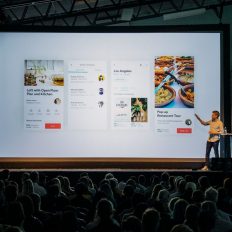2022 marks the 20th year of the Experiential Marketing Summit and the occasion was marked with the 3-day conference held at the MGM Grand in Las Vegas! Represented in the attendees were Agencies, Brands and Vendors, all excited to be connecting in person once again. The ability to connect in person was a refreshing reminder of how things have shifted towards a familiar “normalcy” again but there have been some significant changes that we all can learn from. Here are five key takeaways we uncovered at EMS 2022:
1. Cut the BS
Being self-aware is key for marketers, especially when it comes to your own event. Ask yourself honestly: is the event you’re organizing one you’d attend yourself? If you don’t care to attend your own event, why should your audience? By being brutally honest, you can reassess your event with more intention to make the experience memorable and exciting for your audience.
2. Resolve Data Overload with Purpose
Data can be gathered in almost endless ways. With that comes such an abundance of information, it is hard to know what to do with it all. Before gathering, ask yourself: why do I need this information? What am I going to use it for? Knowing what the purpose is behind the data will make the way you gather it more intentional and also allow you to know HOW to interpret it.
Virtual platforms unlocked even more data for organizers over the past few years. With hybrid and the return to in-person, event organizers have been getting creative to capture similar amounts of data. At EMS, we saw the use of heat maps, unique content offerings and second-screen activities used in addition to using QR codes for attendance and networking tracking. If used intentionally and creatively, onsite data gathering can elevate the attendee experience while also answering your most important questions.
3. Don’t Just Be Better. Do Better.
The terms DE&I and Sustainability are used a lot in the marketing world. But these are more than just buzzwords. It’s important to be actionable with these topics as well. When looking at the attendee journey, is this inclusive for everyone? Look at the venue itself. Are sustainable infrastructures available at your event? No? Remember our first takeaway – cut the BS. Be direct. Build it into your contracts with vendors. Incorporate policies into your organization that reflect these initiatives. Moving forward with these new practices will ensure you are offsetting your waste and energy consumption and being empathetic towards the needs of your team and audiences.
4. Audiences Expect Convenience
Webex shared data from their network of thousands of event organizers and most agreed that they planned to host a mix of event formats in the upcoming years. Several brands shared that they could have had a greater impact on their audience by providing virtual programs rather than requiring everyone to engage in-person. Meanwhile, organizers also noted some events struggle to see success when only offering a virtual option and they will need to return in-person.
One theme ran true throughout the conference when deciding the best format: consider your event objectives against the strengths of the different formats. Are you trying to reach as many people as possible? Are you trying to develop culture and connections for your organization? Are you looking to share educational content? Are you trying to build a community for users? While your event objectives are key, the audience is in the driver’s seat. If your event doesn’t offer enough value for them, they will not engage. So, think carefully about how you can balance your goals with audience expectations for convenience and ease of access.
5. Consistency Builds Loyalty
It’s common knowledge that an event, while a peak experience, is just one touchpoint in the continuum of brand experiences for target audiences. But nothing throws off this journey more than inconsistency in your brand messaging. If an event isn’t aligned with the key marketing messages and vice versa, the inconsistency reflects your organization as just that. By having the marketing and event teams on the same page, your events will feel more like a natural extension of your brand with visuals and cadence reflecting the same key messaging at all brand touchpoints. Find ways to help each other strengthen the collaboration. The data gathered on where the target audiences are gravitating to is invaluable for your content and editorial teams. You invest so much in the content throughout your programs; make sure you are repurposing and driving conversation well after the audience goes home. This consistency will increase ROI because your efforts will be working in sync, not silos.
All in all, EMS 2022 was a reminder of the impact our events have for attendees. By being more intentional with our event decisions, from inclusivity and sustainability to consistency and convenience, not only are we connecting with our target audiences but also connecting once again to our brands in ways that we haven’t been able to in some time. It’s an exciting time for marketing and with thoughtful purpose set behind it, we can take our events to the next level. You can bet on that.



